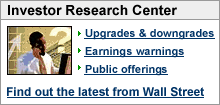Santa has left Wall StreetIf the stock market's recent performance is any guide, December may not be so sunny on Wall Street.NEW YORK (CNNMoney.com) -- December has been one of the best months on Wall Street since the 1950s, thanks to the Santa Claus rally and other seasonal factors. But for the past few years, Santa has been arriving earlier and earlier.
This year, perhaps wary of the holiday crowds, Santa appears to have come so early that he handed out all his gifts and left in time to get home for Thanksgiving. That's not to say that the Grinch is likely to take his place this month, with the more than four year old bull market not necessarily ready to step aside. But many market analysts argue that the recent run - which has propelled stocks for four and a half months - is probably it for 2006. "Santa definitely came early this year," said Ben Halliburton, chief investment officer at Tradition Capital Management, who said he expects the market to consolidate in December, with the S&P 500 likely to churn in a range of about 2 percent in either direction. Why? "We've just had a big move up for the stock market and the economic news lately has been weak," Halliburton said. He said that the likelihood of a recession next year is probably 50-50, and depending on the economic environment, corporate profits and stock prices could be in trouble next year. All of that could keep investors on hold this month. "You're in an emotionally driven market and a liquidity driven market, but at some point, reality has to set in," said Jim Melcher, president of Balestra Capital. Since bottoming in July, stocks have been on a tear, with the three major gauges posting gains in August and September - typically bad months - October - typically a ho-hum month - and November - usually a good month. The Dow Jones industrial average hit record highs 22 times in October and November. The S&P 500 index and the Nasdaq composite are near six-year highs. The Russell 2000 index of small stocks hit a record high earlier this month. So far this year, the Dow is up 13.8 percent, the S&P 500 is up nearly 12 percent and the Nasdaq is up around 9.5 percent, as of Friday's close. The Russell 2000's gain is the biggest, just exceeding 16 percent. The gains have been fostered by the continued impact of strong earnings, lower oil prices and a Federal Reserve that seems to have ended its more than two year interest-rate-hiking campaign. However, these gains have also coincided with the view that the economy is headed for a "soft landing," and that view has been thrown into question of late. Barry Ritholtz, chief market strategist at Ritholtz Research, said a soft landing is almost like a unicorn, in that it is a "rare, mythical creature that is the exception, not the norm." By most accounts, 1995 was the last time one was seen and before that, not since the late 1960s. "There's a lot of stuff going on right now not consistent with a healthy economy," Ritholtz said. "Manufacturing is contracting, consumer spending is slowing, and housing and autos are likely in a recession already." Meanwhile, core inflationary pressures - which exclude volatile food and energy prices - have not come down as much as some experts have expected, commensurate with the economic slowdown. As a result, some Fed officials are calling for the central bank to lift rates again, before cutting them. Worries about the economy and the threat of higher rates in 2007 - following the recent rally - equals a market that's going to tread water at best. December: good or erratic December has been the best month for the S&P 500 since 1950, with the index posting an average gain of 1.7 percent, according to the Stock Trader's Almanac. For the Dow Jones industrial average, it's the second-best month, with the blue-chip barometer seeing an average gain of 1.8 percent over that time. December has also been the second-best month on the Nasdaq since its inception in 1971, with the tech-fueled index posting an average gain of 2.1 percent. Typically, stocks start the month strong, dip in the middle of the month and then rally at the end and into early January That's due to the impact of year-end dividends, bonuses and payouts and the so-called January effect: the tendency for individual investors to sell stock losers ahead of Dec. 31 for tax purposes and then buy them back later, which gives the markets a boost. In recent years, this has also been happening earlier and earlier. Oct. 31 is the deadline for mutual fund managers and some big institutional investors to take losses for tax purposes. So that typically brings some selling in October and then a bounce back in the last two months of the year. But in midterm election years like 2006, December returns are typically less impressive, said Jeffrey Hirsch, editor of the Stock Trader's Almanac. In midterm years since 1971, the Dow has been basically flat on average for December, the S&P 500 has risen 0.2 percent and the Nasdaq has risen 0.3 percent. Wall Street is likely to have a more difficult 2006 December than normal in a midterm year, Hirsch said. "There's a lot of potential profit-taking early in the month after the run we've seen," he said. "Add to that all the conflicting economic news we've been getting and you're likely to see a choppy month." Where costs will rise and fall in 2007 Energy industry: give us something solid |
|



